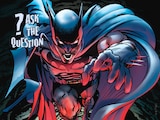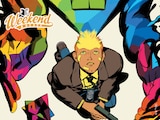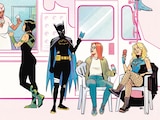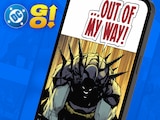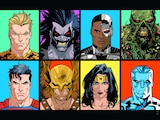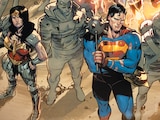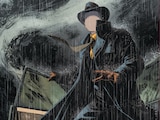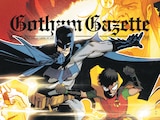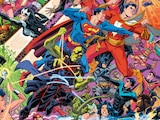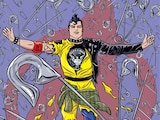Friends, allies, denizens of the DC Universe, my name is Alex Jaffe. Through my travels across the internet, I have become known amongst the DC fandom as HubCityQuestion—a tireless crusader in the pursuit of truth and revelation for all who have ever had a question about DC or its characters. Joining this quest is a simple process: all you need to do is join our official DC Discord server and find me waiting for your inquiry in the #ask-the-question channel. The only time I won’t see you is when I’m sleeping, and I don’t sleep very often.
What kind of question can you ask me? Well, a question like any of these, which represent some of the best and most interesting that were posed to me this past month.

Superman78Fan asks:
Who came up with Bizarro, and how?
That’s a historical point of contention, actually. Bizarro first appeared around the same time in both Otto Binder’s Superboy comics and Alvin Schwartz’s daily Superman newspaper comics. Neither ever relented in the claims that they created him.
As far as inspiration goes, Binder would cite Frankenstein’s monster as what led to the idea of Bizarro, while Schwartz cited the work of psychologist Carl Jung on the concept of the “shadow self.”
Cornholio asks:
Hi HCQ, I was wondering if the Bizarro in Red Hood and the Outlaws is the same one that’s currently a villain?
This is a good time to clarify that there are two kinds of Bizarros in the DC Universe right now: the imperfect Bizarro clones of Superman created by Lex Luthor, and the Bizarros of Earth-29, a universe where everyone’s Bizarro counterparts live—also known as Bizarro World.
The Bizarro featured in Red Hood and the Outlaws was one of the former clone Bizarros. When Red Hood and the Outlaws ended, the Outlaw Bizarro had secured a ruling place for himself in Hell. For all we know, that’s where he remains to this day. Since then, the Bizarro featured in, for instance, Jason Aaron’s recent Action Comics story, “I, Bizarro,” is the Bizarro of Earth-29, Bizarro World. The origin of the Bizarro featured in Amanda Waller’s Suicide Squad, as recently as Suicide Squad: Dream Team and Absolute Power, is less clear, but is most likely another iteration of Luthor’s Bizarro clones. If you’re concerned about the Outlaw Bizarro, then for now it’s safe to say that he’s perfectly happy in the worst place imaginable.

Comedy Alpha asks:
Why does DC like the number 52 a lot? Is there a specific reason as to why? Because 52 sounds like a really specific number.
It really started with the 2006 series 52, which was named such because it was a weekly series covering a real time year of the DC Universe for 52 weeks. The series was a big hit for DC, so when Dan DiDio was working to relaunch the DC line in 2011 and had 48 new books lined up for it, Jim Lee suggested upping the number to 52. After all, they’d had good luck with it before. And so, 52 became a motif.
superthebillybob asks:
Was curious to know what creative team has done the most titles at DC? Of course, I think of Scott Snyder and Greg Capullo, but I'm guessing there may be some other writers and artists with a longer history of collaborations.
This was one of the tougher questions I’ve gotten recently. There’s no easy way to cross-reference this that I know of. I ended up having to confer with one of my associates, CBR’s Brian Cronin, and together we surmised that the creative team who has collaborated on the greatest variety of titles under the DC banner would have to be Robert Kanigher and Carmine Infantino. Over three decades of collaboration, Kanigher and Infantino worked on no fewer than 18 titles together—and nobody’s beating that.

Souron1 asks:
Here’s a weird question. At the end of the Batman: Their Dark Designs collection, there are these three weird ten-panel minicomics. Do you know if they were published anywhere else? Or why they were included?
Oh yes! At the time, DC was experimenting with posting supplemental comics to the main Batman title exclusively for their Instagram page. That’s why they’re formatted that way, for Instagram users to swipe through panel by panel. These experimental comics were shelved pretty quickly but are preserved here.
Arkham Knight asks:
How long did the status quo of Kyle Rayner being the only Green Lantern last?
Kyle became the only Green Lantern in 1994, after Hal Jordan destroyed the Corps in Emerald Twilight. John Stewart became a Lantern again in 2002, and the Corps as a whole came back with Green Lantern: Rebirth in 2004. So, a good ten year run, altogether.
Aristocratic asks:
What lasso did Wonder Woman wield in her comics after Cheetah stole her gear?
During the Year of the Villain storyline you allude to here, Diana goes to battle with her feline nemesis by borrowing a lasso from Peng Deilan, the Wonder Woman of China. Deilan, who has an alternate, ancient magical snake form, wove the lasso from her own hide.
I know what you’re thinking: “Wow, that sounds badass.” There’s a good reason for that. It is.

Mithrophon asks:
A couple of Aquaman continuity questions: Did he get his hand back, or is it still gone? And did they ever retcon Arthur Jr's death at the hands of Black Manta, or is that still canon?
Aquaman’s missing hand returned when he was resurrected at the conclusion of Blackest Night, along with a handful of other formerly deceased characters on a specific mission for the White Lantern Entity.
As for Arthur Junior, apart from a brief fantasy sequence in the 2017 Aquaman Annual, his death hasn’t come up since the Flashpoint event. You can’t prove a negative, though, so all I can say is that no one has addressed whether it happened or not. But considering that Aquaman would probably remember something like that in his recent fights with Black Manta, it’s likely safe to assume that it’s no longer a historical factor. At least, not until someone chooses to address it.
Cinqo35 asks:
Have there been any stories (besides crossovers) with the Royal Flush Gang and the Joker interacting with each other?
A couple, sure. The most famous is 2003’s Justice League episode “Wild Cards,” where the League battles an incarnation of the Royal Flush Gang controlled by the Joker in what would prove to be his last battle against the team in the DC Animated Universe. But their earliest encounter goes back to 1975’s The Joker #5, where Joker competes with the Royal Flush Gang as they both attempt to steal some art.

Moonlight asks:
Who’s the green speedster?
It’s not a speedster wearing the green suit in this month’s Justice League Unlimited #1, but a fairly obscure superhero—Harold Jordan, the young hero Air Wave! Known generally for appearing near the front of any Who’s Who collection thanks to the good fortune of having a name that starts with an “A,” and his ability to transform into a living transmission signal. Also, he’s Hal Jordan’s cousin.
Amazing Jedi-Man asks:
What villain (other than I’m guessing the Joker) has been in the most Batman/Detective Comics issues?
Your first guess is right. It’s the Joker, by a wide margin. After him, it depends on how strict you want to be about the “villain” classification. It might be Catwoman, but many of her appearances in Batman and Detective Comics, especially since 1990, have not strictly been as an antagonist. If you want to discount her, then our second-most frequent Batman foe would actually be the Penguin.
Jasom asks:
Is Barbara Gordon still Jim Gordon’s adopted niece? Who were her parents?
Prior to Flashpoint, Barbara Gordon’s parents were Jim’s brother, Roger Gordon, and Roger’s wife, Thelma. Thelma was killed in a car accident and accounts vary on whether Roger died with her, or drank himself to death soon after. Either way, in 2000’s Batman: Gotham Knights #6, a letter from Thelma reveals that Jim might have actually been Barbara’s father all along, as she had dated Jim before meeting his brother and became pregnant soon after.
After Flashpoint, DC uncomplicated the whole situation by just making Jim Gordon Barbara’s father, starting in 2011’s New 52 Batgirl series.

MyDoom asks:
Hi HCQ! Who's Cass Cain's love interest?
In most of her appearances, Cassandra Cain usually doesn’t have a love interest. But over the past 25 years, she’s racked up a few brief flirtations. Her first serious romantic interest was Tai’Darshan, a metahuman Tarakstani freedom fighter. He first appeared in 2003’s Batgirl #39 and died in Batgirl #44.
During the uncertain course of that brief relationship, Cassandra also flirted with the idea of a possible romance with Conner Kent, going on a single date with Superboy in Batgirl #41. They never saw each other romantically again after that instance.
The 2004 miniseries Batman: City of Light introduces a busboy named Javier who takes an interest in Cassandra, but his affections are not returned.
In 2005’s Batgirl #60, during her stay in Blüdhaven, Cassandra met a boy who went by “Zero” whom she began striking up a potential relationship with. Unfortunately, Zero was soon among the many Blüdhaven casualties when Chemo dropped on the city in Infinite Crisis.

While non-canonical, an alternate future presented in 2006’s Solo #10 (above) depicted Tim Drake and Cassandra Cain as a married couple.
In the 2008 Batgirl miniseries, one of Cassandra’s ESL classmates, a boy named Sal, asks her out. But after the miniseries, he never appears again.
The latest love interests we’ve seen for Cassandra have been a boy named Erik, a frequent visitor of the Gotham Public Library in the non-canonical Shadow of the Batgirl graphic novel, and possibly the young Dr. Chin, whom Cassandra rescues from kidnappers and then shares some boba tea with in 2021’s DC Festival of Heroes: The Asian Superhero Celebration.
It’s a pretty long list all together, but as you can see, none of them have lasted in the long term. Cassandra’s most enduring, closest relationships through the years have been with her fellow Batgirls, Barbara Gordon and Stephanie Brown.

ShatteredSeraph asks:
Has the Harbinger appeared in comics not related to Crisis on Infinite Earths? If so, what kind of role does she take?
After the Crisis, Harbinger was among the emissaries chosen in 1988’s Millennium event to become one of the New Guardians, a team designed to guide humanity’s future. That team lasted about a year before its members went their own ways. But Harbinger found a new home on Themyscira in the aftermath of 1991’s War of the Gods event, taking a new role as the Amazons’ record keeper. Harbinger remained on Paradise Island until 2004’s Superman/Batman #10, laying down her life against the forces of Darkseid which had arrived to abduct Supergirl from the island.
Today, as seen in The Multiversity and beyond, the spirit of Harbinger lives on as the central consciousness of the House of Heroes, the hub of the multiversal superhero team Justice Incarnate.
MR. POLL asks:
Why does Batman have a hole in his mask?
No real consistent canonical explanation has ever been presented. In Brian Azzarello and Lee Bermejo’s Joker, Batman’s only line of dialogue is to explain to the Joker that it’s simply there to mock him. Personally, I believe there’s another reason: Batman keeps part of his face visible so that, up close, he can assure those he has to rescue that he’s human. Batman’s function is to be a terror at a distance, and a savior up close.
But regardless of our distance, yours truly is always approachable with whatever mysteries you seek to conquer. Simply pay a visit to our official Discord server, where I may always be found. You may even find yourself in the next edition of ASK…THE QUESTION.
Alex Jaffe is the author of our monthly "Ask the Question" column and writes about TV, movies, comics and superhero history for DC.com. Follow him on Bluesky at @AlexJaffe and find him in the DC Official Discord server as HubCityQuestion.
NOTE: The views and opinions expressed in this feature are solely those of Alex Jaffe and do not necessarily reflect those of DC or Warner Bros. Discovery, nor should they be read as confirmation or denial of future DC plans.




